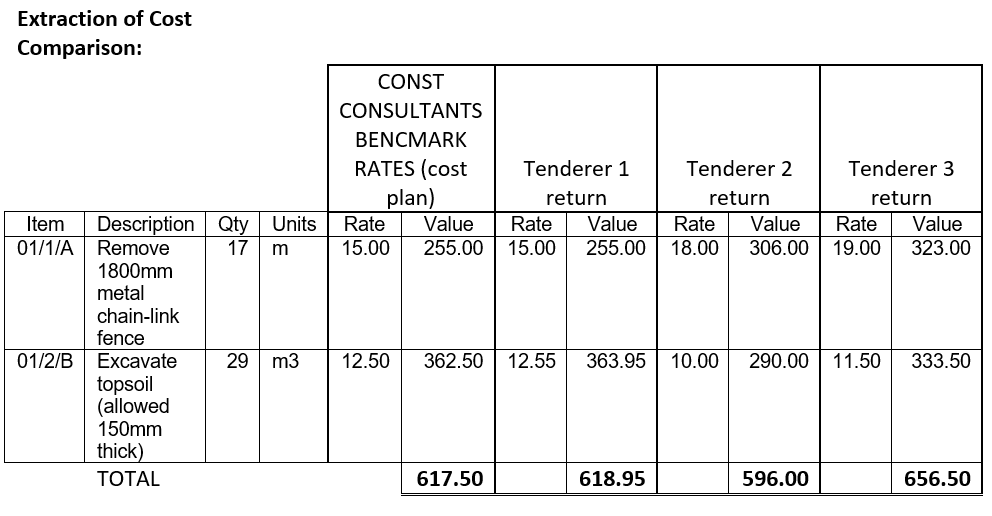Tender price appraisal in the construction industry
Contents |
[edit] Introduction
A tender is a submission made by a prospective supplier in response to an invitation to tender (ITT). It makes an offer for the supply of goods and/or services. An invitation to tender might be issued for a range of contracts, including; equipment supply, the main construction contract (perhaps including design by the contractor), demolition, enabling works, and so on.
Once tenders have been received, a thorough process of assessment is undertaken to identify the preferred tenderer. The tender pricing document is a key aspect of the tender return that will be assessed by the cost consultant to determine where value lies within the different tenders and to enable a like for like comparison between tenderer prices.
[edit] Preparation
To ensure a like for like comparison, the tender consultants need to ensure that a standard format is completed by all tenderers. The format of the document can be different depending on the form of contract selected.
Examples of pricing formats include:
- Bill of quantities (with quantities).
- Bill of quantities (without quantities).
- Schedule of rates.
- Contract sum analysis.
- Any other bespoke template formulated by the tender consultants.
[edit] Assessment
The tender price assessment will commence once all tenders have been received and opened and reviewed for compliance. Non-compliant tenders may be excluded unless they were specifically permitted in the invitation to tender.
The pricing comparison will then be carried out by a cost consultant. The cost consultant will use their own benchmark document to compare the tender prices against.
The assessment will enable the consultant to:
- Provide a like-for-like comparison between tenderers and the cost plan (benchmark).
- Assess value for money.
- Check arithmetic.
- Identify significant differences in pricing to ensure tenderers have interpreted the specification correctly.
- Identify potential areas of savings that can be negotiated with the tenderers.
- Review rate distribution (ensure that the tenderers have not front loaded the project).
- Prepare a tender report.
[edit] Review and action
Arithmetical errors will need to be reviewed in accordance with the tender guidance rules. Government contracts might have strict guidance on the correction of errors and disallow contract sum changes. The private sector might be more lenient and allow price reduction corrections. It is important to capture any changes and confirm this in writing and keep records of any communication.
Any other areas of qualification by tenderers must also be assessed. Tenderers might add qualifications to their price that will influence the contact sum. An example is a clarification that might limit the tenderers price to only a certain depth when it comes to excavations.
Any other big price discrepancies should be highlighted and reviewed. If a price is too low it can also be a risk to the project. The project can become a financial burden on the tenderer and they are unlikely to perform satisfactorily. The cost consultant will have to assess the reason for the low price. If it is due to misinterpretation of the design or low wages, it can have an impact on the outcome of the project. It is important to distinguish between a legitimate keen commercial price and a non-compliant tenderer price.
The cost consultant will provide a summary of the cost assessment and conclude with a contract sum that will form part of the tender report and subsequently become part of the contractual documents.
However, the tenderer with the lowest price may not necessarily be awarded the contract, as other criteria such as experience, availability, value for money and so on may also be considered. For more information see: Selection criteria.
[edit] Related articles on Designing Buildings Wiki
Featured articles and news
RTPI leader to become new CIOB Chief Executive Officer
Dr Victoria Hills MRTPI, FICE to take over after Caroline Gumble’s departure.
Social and affordable housing, a long term plan for delivery
The “Delivering a Decade of Renewal for Social and Affordable Housing” strategy sets out future path.
A change to adoptive architecture
Effects of global weather warming on architectural detailing, material choice and human interaction.
The proposed publicly owned and backed subsidiary of Homes England, to facilitate new homes.
How big is the problem and what can we do to mitigate the effects?
Overheating guidance and tools for building designers
A number of cool guides to help with the heat.
The UK's Modern Industrial Strategy: A 10 year plan
Previous consultation criticism, current key elements and general support with some persisting reservations.
Building Safety Regulator reforms
New roles, new staff and a new fast track service pave the way for a single construction regulator.
Architectural Technologist CPDs and Communications
CIAT CPD… and how you can do it!
Cooling centres and cool spaces
Managing extreme heat in cities by directing the public to places for heat stress relief and water sources.
Winter gardens: A brief history and warm variations
Extending the season with glass in different forms and terms.
Restoring Great Yarmouth's Winter Gardens
Transforming one of the least sustainable constructions imaginable.
Construction Skills Mission Board launch sector drive
Newly formed government and industry collaboration set strategy for recruiting an additional 100,000 construction workers a year.
New Architects Code comes into effect in September 2025
ARB Architects Code of Conduct and Practice available with ongoing consultation regarding guidance.
Welsh Skills Body (Medr) launches ambitious plan
The new skills body brings together funding and regulation of tertiary education and research for the devolved nation.
Paul Gandy FCIOB announced as next CIOB President
Former Tilbury Douglas CEO takes helm.
UK Infrastructure: A 10 Year Strategy. In brief with reactions
With the National Infrastructure and Service Transformation Authority (NISTA).























